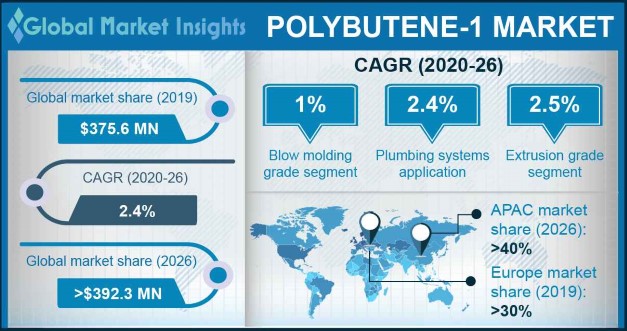Home > Chemicals & Materials > Specialty Chemicals > Custom Synthesis > Polybutene-1 Market
Polybutene-1 Market Size
- Report ID: GMI4669
- Published Date: May 2020
- Report Format: PDF
Polybutene-1 Market Size
Polybutene-1 Market size was USD 375.6 million in 2019 and will grow at a CAGR of 2.4% from 2020 to 2026. Increasing production demand from plumbing systems and easy-peel packaging across the globe will drive the market growth during forecast period.
Polybutene-1 is a member of polyolefin polymers family and it is consumed in various end-use industries owing to its unique properties. The polybutene-1 market share is highly isotactic thermoplastic with expectational thermal, mechanical, and chemical resistance properties. These properties make it ideal for certain applications such as pressurized cold & hold water piping.
The product is used in various customer applications such as film medication, hot melt adhesives, easy-open packaging, hot water tanks, and piping systems. It has outstanding creep resistance and flexibility over wide temperature range; thus, it is majorly used in piping system.
The product is the primary raw material in production of PB-1 piping system and easy-peel packaging. Piping demand has been increasing due to rapidly increasing urbanization across the world. Rapid urbanization has created tremendous opportunity for polybutene-1 market in Asia Pacific and Latin America. Furthermore, phasing out of traditional building and construction materials has raised the demand for new materials with superior characteristics.
| Report Attribute | Details |
|---|---|
| Base Year: | 2019 |
| Polybutene-1 Market Size in 2019: | 375.6 Million (USD) |
| Forecast Period: | 2019 to 2026 |
| Forecast Period 2019 to 2026 CAGR: | 2.4% |
| 2026 Value Projection: | 392.3 Million (USD) |
| Historical Data for: | 2016 to 2019 |
| No. of Pages: | 105 |
| Tables, Charts & Figures: | 102 |
| Segments covered: | Product Grade, Application, Region |
| Growth Drivers: |
|
| Pitfalls & Challenges: |
|
For instance, in high rise building, plumbing engineers are considering new materials for piping systems due to elevated pressure and additional forces. Conventional designs and materials are often not adequate for such conditions. Thus, in European nations plastic plumping products have witnessed rapid penetration and are hence replacing traditional metal components over last few decades.
The polybutene-1 market outlook is expected to be driven by demand from polymer convertors. High demand growth and lack of capacity expansion shall drive higher capacity utilization, increasing the supply of product during the forecast period.
Polybutene-1 has major application in easy-peel packaging or seal-open packaging. Easy-opening packaging largely used for cartons liners, pre-packed products such as cheeses, meat, fish, cereals, etc. Consumers have various requirement towards food packaging and other easy open packaging. Busy lifestyle of consumers along with demand for ready to eat meals has created tremendous demand for easy-open packaging. Increasing packaging demand shall drive the polybutene-1 market application in easy peel packaged products during forecast period.
Growing end use industries such as packaging, plumbing, etc., shall drive the polybutene-1 market demand over forecast period. However, even though product prices remained stable last few years, they are highly susceptible to raw material prices. Prices depend on feedstock material butene-1 and tight supply of butene-1 can increase the product prices exponentially. Furthermore, there are only five manufacturers in the world that produces the product.
Global polybutene-1 market is oligopolistic in nature where handful of manufacturers have total dominance over production capacity. However, regional markets can be monopolistic in nature, where one producer has total control over regional market. For instance, in Europe LyondellBasell is sole product manufacturer with highest production capacity in the world. The company supply Polybutene-1 to regional PB-1 end use product manufacturers.
Polybutene-1 is a very promising product. However, it has been facing some legal challenges in North America. Stringent regulatory environment in North America poses a great challenge to overall polybutene-1 market growth potential, particularly for plumbing application. Monopolistic nature of market can attract newcomers thus, decreasing dominance over market of current players.

